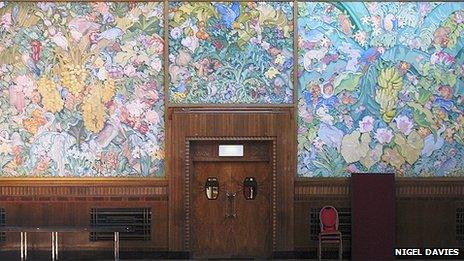Swansea's Brangwyn Hall to close for facelift
- Published

The hall is named after the artist Sir Frank Brangwyn, whose murals hang in the venue
Swansea's Brangwyn Hall is to close for a year-long restoration project at the city's Guildhall.
The Grade I listed concert and conference venue will see its whole structure given a facelift, from its roof to windows and electrical wiring.
The hall is named after the artist Sir Frank Brangwyn, whose colourful murals are housed there.
Art conservationists have been appointed to ensure the works are protected during the restoration.
"The Brangwyn Hall is one of Swansea's key cultural assets which has played host to some of the biggest names in the music world over the years," said Nick Bradley, Swansea council's cabinet member for regeneration.
"These works are essential for ensuring that the Brangwyn Hall is protected and restored for future generations of visitors to enjoy."
The council said the restoration work will cost "millions of pounds", and involves rewiring, replacement of existing heating systems and weatherproofing works.
The fabric of the building will also be upgraded and restored, including roof coverings, windows, internal and external stonework and carpentry.
"Following the works, the council will be re-launching the facility as one of the city's premier venues for major public events, including conferences, exhibitions, concerts, festivals, weddings, dinners and so on," added Mr Bradley.
"I am delighted to say bookings are already being received for 2014 and beyond."
'British Empire' panels
The historic building opened in 1934 and enjoys iconic status in the city after surviving the Blitz during World War II.
The hall is internationally renowned as a classical music venue because of its acoustics, attracting orchestras and singers from all over the world.
But its most striking feature is the series of murals by Sir Frank Brangwyn.
An official World War I artist, Brangwyn was commissioned in 1924 to paint the murals for the Royal Gallery in the Palace of Westminster.
The images were to represent the British Empire, but when he presented them in 1930 they were rejected as "inappropriate".
Offers to house the panels then came in from around the world, but as the son of a Welsh architect, it was Swansea that became their home.
The council said that as part of the restoration project, the 17 panels in the hall will be subject to a survey, and the installation of "suitable protection" during the work, which starts in mid July.
The last events before the refurbishment will be university graduation ceremonies.